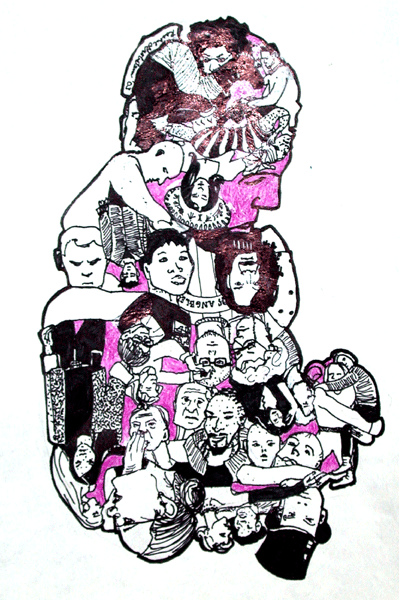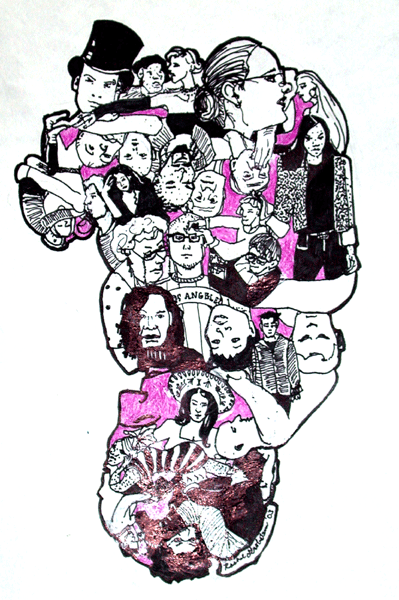Made available on Serendip
In association with Making Sense of Diversity: An Exploration, a world wide conversation

|
January 20, 2006
Nell Anderson and Chris MacDonald-Dennis
Engagement with Community and Diversity through PRAXIS
Participants
Summary
Prepared by Vanessa Christman
Additions, revisions, extensions are encouraged
in the On-Line Forum
| 
|
Introductions . Nell Anderson and Chris MacDonald-Dennis began by asking the students helping to facilitate (Tiffany Reed, Christina Gubitosa, Lindsey Giblin, Aheli Purkayastha, Zanny Alter, Melinda Barbosa and Tiffany Shumate) to introduce themselves. Then they extended the invitation to everyone attending the conversation.
Origins. Chris MacDonald-Dennis, Assistant Dean and Director of Intercultural Affairs, then addressed where the idea of service learning came from and shared some of his experiences around community and engagement. He was working at the University of Michigan before coming to Bryn Mawr, and service learning was very important there. (“It's the premier place for service learning,” Nell added, “and produces the only journal committed to service learning.”) Students work in the community doing social service—working with non-profit agencies.
Michigan's program, and the idea in general, is based on the concept that students learn best when they do and when they reflect on what they do. Both components are derived from the philosophy of John Dewey, who at the start of the 20 th century proposed Experiential Education. What? So What? Now what? These are the key questions asked in the program at Michigan.
Making a connection to the theoretical work behind the service learning is especially good; students can say, “Oh—this is what I read!” Also, the best way to learn about diversity is service learning. In studying institutional racism, for example, students may say, “I don't know what that looks like—show me what that looks like.” If those students do a service project on 8 Mile (which divides Detroit from the suburbs, not the Eminem movie) picking up trash all week—they see blacks on one side and whites on the other. They notice the similarities and differences. They notice that people are treated differently (in services provided, e.g.).
Chris would like to believe a service-learning experience begins a life-long commitment to social justice. He feels that it also challenges the perception that it is white students working in communities of color.
Praxis at Bryn Mawr. Nell Anderson, Praxis Program Director, explained that it is not called service learning at Bryn Mawr, but Praxis, which is community-based learning. It began as an idea in many people's hearts and minds here for many years. Alumnae have had huge impact, she said. Undergraduates had a commitment to activism, but until the alumnae spoke up, their work never had a chance to be validated/supported by the institution or tied into their learning. Alumnae began the process; then the faculty joined in, and once Nancy Vickers arrived they formed a steering committee. Praxis was born—and at three levels:
Praxis I = course + field work 2-4 hrs./week (25%) for the full semester
Praxis II is interdisciplinary.; students do about 50% of their work in the field—teach their art to others = arts teaching, which is designed only as Praxis course.
Praxis III is an independent study. You develop a course in an area you're interested in. It's usually off campus, but sometimes unique Praxis courses, like Rachel Robbins painting a mural in the Women's Center, happen right at Bryn Mawr. The student meets with a faculty advisor and a field supervisor.
Reflection occurs in the classes, encouraged by faculty. Students build relationships with schools and other organizations (including, for example, the City of Norristown). The focus on partnership is the thing Nell is most proud of.
Our students speak . Nell asked some of the students who have been in Praxis in the last year to talk today. She had given them the following guiding questions in advance:
How do you understand the reciprocal nature of the fieldwork relationship?
What did you learn about yourself through your Praxis experience?
What role did "difference" play in that learning?
What was most challenging to you in engaging with this field site?
Melinda: She did not see her involvement as doing service— the attitude that prevailed was “We're doing this together.” She could be an activist. “There is no outside place to make policy for us,” she said; “in that classroom we can make a change working with what we have. Let's work it out together. I am not an expert, but we share knowledge.”
Tiffany Reed: “'Service' makes me want to puke. It was not me performing a service for the teacher or students or them putting up with me—it was a little of both.” She explained that as a white female from BMC going to communities of color, she was greeted with a lot of suspicion—foremost, it was the Bryn Mawr thing, the upper-crust reputation. Assumptions about her and her background were made. She feels that high school students are far more aware than she was when she was in high school. They have experiences to offer her as well. Once the students realized they had to trust and connect with her for this to happen—that she wasn't there because she needed to be there to get credit, that she would show up every week and was interested in them and their learning, their struggles—they overcome distrust.
Christine was at Overbrook, with whom BMC has a relationship. She feels, “What they give is so much more than what we can give them.” Their classrooms are already overcrowded, and they open up the classroom to Praxis students. It is reciprocal—Praxis students come back to Bryn Mawr glowing with stories that were shared at their site. “We're more fun than teachers,” she noted. “Strong bonds are formed. Bryn Mawr students are resources—can give college advice. But we are novices and the students put up with that.” She confessed that she was not always as honest as she should have been with the students—she didn't want to dash their ambitions. “But,” she concluded, “it comes across if we're really invested.”
Lindsey has done a lot of Praxis hours. She said it keeps her sane. She has been involved in the CPIA partnership (http://www.brynmawr.edu/cpia/). “You could go through Bryn Mawr without ever setting foot outside PSB,” she warned.
Zanny saw similar initiatives in her own high school, but the students were resentful, didn't trust those coming in. Now she's on the other side. She values the commitment—the staying with something. “There was no ongoing relationship with my high school, but here there was, and that made the difference,” she explained. She also said it raised a larger question: How do you show someone that you care?
Tiffany Shumate worked with kindergarten students, observing them and helping them with reading. She learned she wants to focus on education policy from the readings in class. “I had four Praxis courses last semester. Because of the Praxis courses, I know that education reform is what I'd like to focus on now,” she disclosed.
Bringing it back to the whole group, Nell pointed out that it was interesting that the student facilitators ended with school reform. Praxis gets students to that Now what? phase very early on. Chris thanked them for saying and getting that it is community based learning. “You realize you get just as much—and a lot of people don't get that, especially at elite schools.” In the past, research was done—people were used. “What are they gonna come and take from us?” was the perception. But Bryn Mawr offers a different approach. “Something wonderful is happening,” he said.
Some thoughts shared by the others attending:
We want to get to know you personally.
It's important to view Praxis in the context of a diversity conversation. Each of us is having a different experience—regardless of our background, we are having a unique experience. It takes place at the human level.
I loved being self-directed with support.
It allows privilege group members see how others see them. You get to see something that is a gift.
Do not assume that if you are of a similar ethnicity to the students, that “it's all gonna be down”. You can't say, “I know”—you must listen—can't assume.
People in New Orleans said it was stupid to fly students down there—why would you spend all of this money to have rich kids come down South to have something to put on their resumes/applications? It's very hard to find your way around something like that.
It's a constant process. You want a community to say what is important to them.
When you're into the situation, you get something from it. You could have just donated money or books. . . . You do gain.
This is all very important when we think about education. Do we surround ourselves with ideas and people who see the world the way we do (the concept of the Ivory Tower)—or the way we don't? We should not just be looking for confirmatory information.
It's not just about intentions, but what do you leave with. On the one hand, those kids are still at Overbrook. “It stays with you, though. It's inside you—you take it with you.” You can recharge the activist in you—it goes beyond the 10 weeks. It's no longer about just doing your work, writing your papers.
It's about how community is defined: “I'm not entering into another community that is separate from me—but we are all one community.” You see layers of education, how policy affects it. “[You see] we are existing in the same world. [You see] how we affect each others lives.”
| Return to Schedule for Friday Noon Conversations

| Bryn Mawr Conversations
| Archived
Forum
| Archive of Bryn Mawr Conversation
| General Conversation
| Serendip Home |
These pages are sponsored by the Bryn Mawr College Office
of Intercultural Affairs, the Center for Science and Society and the Serendip
website. Send us additional comments or suggestions at Serendip
© by Serendip 1994-
- Last Modified:
Wednesday, 21-June-2005 15:18:00 EST

